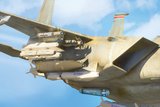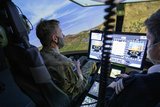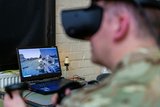The A-29 Super Tucano – the close air support solution (Studio)
Brought to you in partnership with Embraer
The capabilities of the Embraer A-29 Super Tucano make it an ideal option for European air forces as they look to their close air support (CAS) and training needs.
Today, the Super Tucano is in service with 15 countries, ranging from Embraer’s domestic Brazilian market to Nigeria.
Recent customers are ‘very happy about its capabilities, operational range and air-to-ground’ capabilities, said Ilker Aktaşoğlu, Shephard Defence Insight manager.
Noting that the US Air Force Special Operations Command (AFSOC) has taken delivery of three platforms, Aktaşoğlu said that ‘if they trust this platform, it means it’s really successful, compared with its competitors’.
The A-29 has notched significant successes in South America, Africa, the Middle East and other regions, although it is not as yet in service in Europe.
However, Embraer has recently received several inquiries from potential customers in the continent, said Simon Johns, Embraer Vice President – Business Development & Sales, Europe & North Africa.
These customers are interested in the aircraft’s potential as a weapons platform, surveillance asset and advanced trainer, highlighting the aircraft’s versatility.
The Super Tucano is ideally placed to perform long-enduring operations because it also costs less to acquire and operate than a fourth or fifth generation fighter.
‘Often the focus is just on the aircraft – clearly, that’s important because the aircraft is designed to meet a specific requirement,’ Johns said.
‘But when you look at the broader picture, we’re looking at the cost of operation, we’re looking at how easy is it to train a pilot to operate this aircraft, how easy it is to maintain this aircraft, because all of that goes to resource, it generates savings in terms of manpower, time and money, and the other fundamental inputs to Ccpability.’
A range of air forces recognise that the Super Tucano is affordable to procure. Still, critically, they also realise it’s much less expensive to maintain and operate, ‘and therefore entirely suited to the protracted nature of the conflicts we’re experiencing today’, Johns added.
This can have a broader impact, allowing operators to preserve their highly capable generation five or upcoming generation six aircraft for more demanding roles.
The aircraft’s design is central to its appeal. A turboprop platform is flexible by nature, capable of taking off from short runways or even dirt airstrips.
Embraer sought to develop a multimission aircraft from the beginning, said Alberto Gomide, the company’s senior manager, product strategy. This is part of the explanation for the high level of success it has enjoyed with the Brazilian Air Force and others.
‘It’s a proven solution in combat missions, and that makes it a much more mature product than the competitors,’ Gomide said.
The aircraft was always designed with the future in mind, with the capacity to upgrade as technology changes: for example, incorporating new weapons, communication suites and sensors, said Gomide.
‘Each customer that contracts for the aircraft requests different and new capabilities,’ Gomide added. ‘It’s evolved customer by customer with these updates.’
In parallel, Embraer has pursued its own investment in the aircraft’s systems, ‘evolving new capabilities to keep the product’s competitiveness’. For example, he highlighted the Super Tucano’s ability to incorporate precision-guided weapons.
The Super Tucano can carry a range of weapon systems, sensors, defensive aid systems, communication systems and more.
However, its core strength is its ability to carry this equipment without compromising performance, whether it’s flying from unpaved runways or more traditional airfields, Johns said.
‘Nothing changes in the attributes of the aircraft, but we have been able to recognise the evolution of requirements from a number of air forces and customers,’ he added. For example, he pointed to the growing focus on connectivity:
‘This aircraft can operate in a fully networked military organisation with access to tactical datalinks and other communication systems. And that, of course, is essential for any air/land operations in that joint environment.’
The ability of the aircraft to adapt to modern systems means it can support operations with the most sophisticated and effective technology on the market, he said. For example, ‘whether it’s on a gen five fighter or a Super Tucano, it’s the same defensive aid system.’
The A-29 has changed the game in countries like Colombia and Brazil, added Gomide, helping to fight terrorism, secure borders and counter insurgencies. Its key selling point is its versatility, he argued.
‘We have a single solution for different roles. We can optimise an air force’s fleet with a single platform for armed reconnaissance, light attack and a trainer,’ Gomide said. ‘You can have the same maintenance and same training, but you can change from one day to another from a training aircraft to a combat aircraft.’
Looking forward, Embraer is focused on ‘making the cockpit experience for the crew as sophisticated as it can be’, Johns said.
This supports two elements, he explained. First, it means operators can use the aircraft as an advanced trainer for fourth- and fifth-generation aircraft. Second, it will further enhance the Super Tucano’s ability to sit at the centre of a fully networked military organisation.
‘That helps optimise the aircraft and deliver the effects it needs to deliver at the right time and the right place.’
As a former infantry officer, Johns has strong insights into the value of CAS for the soldier on the ground, particularly in the context of a growing focus on multidomain operations. His experience has been fundamentally in counterinsurgency, so he knows the importance of a long-endurance asset.
‘Airpower has been a critical element of all those campaigns,’ he said. ‘The Super Tucano has demonstrated that it’s an excellent platform for providing support to land forces and generating confidence across the joint domain in the air/land space.’
More from Studio
-
![Combat-proven capabilities: How precision-strike systems are evolving for tomorrow’s battlespace (podcast)]()
Combat-proven capabilities: How precision-strike systems are evolving for tomorrow’s battlespace (podcast)
Combat-tested technology is being reshaped to counter A2/AD threats, reduce reliance on GPS and enable faster, more autonomous targeting in complex environments. In this special podcast, experts explain how the evolving threat landscape is shaping next-generation strike capabilities.
-
![Energy evolution: How laser defence systems are powering the next phase of air defence (podcast)]()
Energy evolution: How laser defence systems are powering the next phase of air defence (podcast)
Laser-based air defence is moving from promise to deployment as global threats evolve. In this special podcast, we explore how high-energy laser systems are reshaping interception strategies.
-
![Intelligence advantage: How real-time GEOINT is reshaping military decision-making (Studio)]()
Intelligence advantage: How real-time GEOINT is reshaping military decision-making (Studio)
In today’s contested operational environment, adaptability is key. The new Geospatial-Intelligence as a Service (GEO IaaS) solution from Fujitsu and MAIAR empowers militaries by enabling intelligence advantage, combining advanced technology with human expertise to deliver actionable insights.
-
![Training Together: Unlocking Educational Excellence through Military and Industry Collaboration (Studio)]()
Training Together: Unlocking Educational Excellence through Military and Industry Collaboration (Studio)
Military training is ultimately about people. At Capita, training programmes are built on close engagement with partners, delivering an educational approach that can adapt to individual needs, cultivate leadership – and drive wider cultural change.
-
![Enhancing Military Training Through Digital Technology (Studio)]()
Enhancing Military Training Through Digital Technology (Studio)
Digital technologies offer huge opportunities for defence training. However, militaries must adopt an agile approach, placing the needs of their organisations and personnel at the centre of their efforts.
-
![Layered Defence: How new technologies are enhancing armoured vehicle survivability and manoeuvrability (Studio)]()
Layered Defence: How new technologies are enhancing armoured vehicle survivability and manoeuvrability (Studio)
As modern threats evolve, armoured fighting vehicles face a new era of challenges, from loitering munitions to kinetic energy projectiles. Advances in active, passive, and reactive protection systems are crucial to ensuring battlefield dominance, freedom of manouver and vehicle survivability.






















